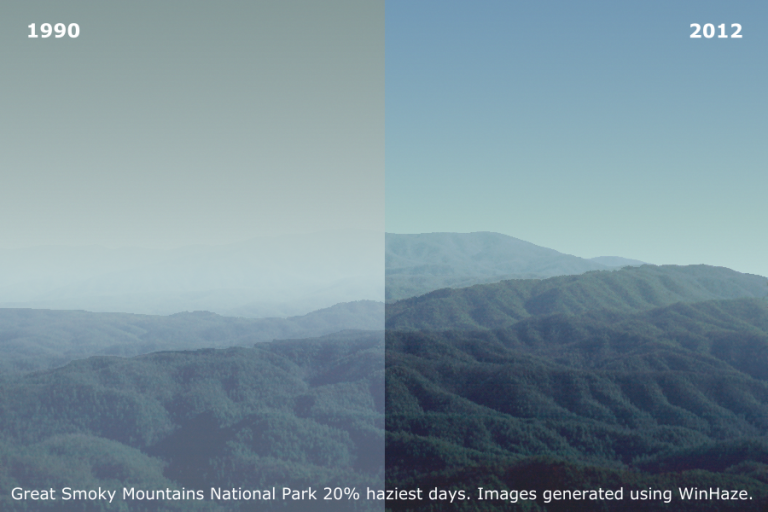By Juan Pablo Quintero
Stanback Digital Marketing & Communications Fellow
Twenty years ago, if you woke up early to hike up Clingmans Dome in the hopes of catching the sunrise, you may have been disappointed. Instead of seeing fog burn off to clear skies, you might have struggled to glimpse the silhouettes of nearby peaks through a haze of air pollution. And if you were out of breath, the hike might not have been to blame.
The famous Smoky Mountains were living up to their name, and not in a good way. Across the state, sulfur and ash from coal-fired power plants were contaminating North Carolina's skies and North Carolinians' lungs.
In 2001, the state's air ranked among the dirtiest in the nation. That led to rising emergency room visits for respiratory issues, increases in health conditions such as asthma, and a grimy pall over the western counties' mountainous scenery.
That changed 20 years ago this month, thanks to a coalition of lawmakers, environmental activists, and N.C. Sierra Club volunteer leaders who rallied to create, approve and enact the Clean Smokestacks Act.
The Act, which took effect in June 2002, was more than a victory for every person affected by pollution in our air. The lessons learned from this campaign are still informing the N.C. Chapter and other groups - in our state and across the country - as we work together today on climate action, environmental justice and other major threats to our air, land, water and people.
 [At right: A comparison of air quality over the Great Smoky Mountains National Park before and after passage of the Clean Smokestacks Act and similar federal policies. Via IMPROVE Program (Interagency Monitoring of Protected Visual Environments)]
[At right: A comparison of air quality over the Great Smoky Mountains National Park before and after passage of the Clean Smokestacks Act and similar federal policies. Via IMPROVE Program (Interagency Monitoring of Protected Visual Environments)]
Passage of the Act "changed the landscape of environmental protection in North Carolina forever,” according to Michael Regan, head of the U.S. Environmental Protection Agency and a native North Carolinian.
"It directly benefited the health of North Carolinians, including myself. And it swung open the door for other environmental legislation to come," he said at an anniversary celebration this spring in Asheville, attended by many of the activists and policy-makers who worked together on the landmark policy.
Much as the Clean Smokestacks Act inspired similar legislation elsewhere, today's environmental advocacy is inspired and informed by the team approach that drove the Act's success, according to Regan and Gov. Roy Cooper, who sent video greetings to the gathering.
"Collaboration is what our thriving clean energy economy is built upon, and that legacy can be traced back to legislation like … the Clean Smokestacks Act,” Cooper said.
The collaborative approach by environmental, public health and other partner groups remains critical to advocating for environmental issues today, according to Wes Wallace, a longtime volunteer leader in the N.C. Sierra Club and a professor of emergency medicine at UNC Chapel Hill.
Twenty years ago, Wallace's impassioned, informed testimony about the impact on public health played a pivotal role in moving state lawmakers to pass the Clean Smokestacks Act.
"Building effective coalitions is key to making progress. You will be working with people who don’t agree with you on everything – if they did, they would be part of your organization," he said recently.
 Another still-relevant lesson is the importance of how an issue is explained to the public, Wallace said: It's critical to express urgency, but not at the expense of hope - to "help people understand that working [to solve] climate change is really good for all of us."
Another still-relevant lesson is the importance of how an issue is explained to the public, Wallace said: It's critical to express urgency, but not at the expense of hope - to "help people understand that working [to solve] climate change is really good for all of us."
"In the environmental community, for far too long we’ve approached communications in a way that seems reasonable to us – focusing on the urgency of the issue, how little time we have, and how dreadful the effects of climate change will be," he said. "What ended up happening was that our messaging was psychologically putting people off. People believed there was nothing they could do, and people quit thinking about it.”
It's equally important to listen to how the public responds to us and understand their concerns, especially when they seem resistant to a position environmentalists think is unambiguous.
"If we don’t listen to them, they won’t listen to us," Wallace said. "If we listen and focus on the values we have in common - protecting the seashore, preserving the ecosystems they rely on for fishing, hunting, or outdoor recreation - people will stop seeing us as enemies but as people struggling with something that is important to them as well.”
Our commemoration of the Clean Smokestacks Act's 20th anniversary isn't about patting ourselves on the back. It's about remembering how we as environmentalists overcame skeptics, industry opposition, political bias and other obstacles to do what was right for our communities.
And it's about drawing on those memories and lessons to address today's most pressing issue - climate change - in a way that includes and empowers all North Carolinians, especially those whose homes and lives are being harmed by it right now.
"We can solve this problem; we know what has to be done," Wallace said. "The solutions are out there."